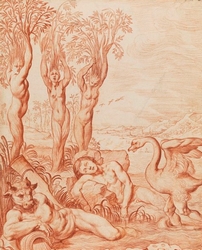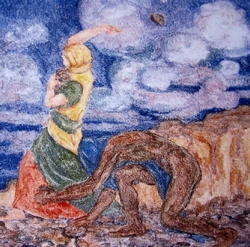THE PHAETHON MYTH AND ANCIENT CATASTROPHISM
Plato introduces his ideas of periodical catastrophes with a deleterious effect on global populations through a rationalisation of the myth of Phaethon, which, in the words of his Egyptian priest, is known both in Egypt and Greece: -
There have been and there will be many and divers destructions of mankind, of which the greatest are by fire and water, and lesser ones by countless other means. For in truth the story that is told in your country as well as ours, how once upon a time Phaethon, son of Helios, yoked his father's chariot, and, because he was unable to drive it along the course taken by his father, burnt up all that was upon the earth and himself perished by a thunderbolt, - that story, as it is told, has the fashion of a legend, but the truth of it lies in the occurrence of a shifting of the bodies in the heavens which move round the earth, and a destruction of the things on the earth by fierce fire, which recurs at long intervals. [Tim. 22cd].
THE MYTH

In Greece, Phaethon was regarded as a son of the solar deity Helios, who was reluctantly allowed to exercise his father's duties with disastrous consequences, scorching the surface of the earth and boiling the waters, inciting Zeus to curtail his endeavours through the use of his divine weapon, the thunderbolt.
The dead Phaethon fell into the Eridanus river, later identified with the Po in northern Italy amongst others, though also associated with the mythical Hyperboreans. Phaethon's sisters, the Heliades, mourned their brother with such sorrow that Zeus, taking pity on them, transformed the girls into poplars, which were believed to be the source of amber, a product of the Baltic region which the Greeks believed came from Hyperborea.
The story was well-known in Plato's time: the tragedians Aeschylus and Euripides wrote plays on the subject, which was also treated by Philoxenus of Cythera.
The best-known version is that of the Roman writer Ovid, who dealt with the subject in his Metamorphoses [1.747-2.366].
In this treatment, Phaethon was the son of Helios and Clymene and an associate of Epaphus, the son of Io and ruler of Egypt, who is ridiculed by his friend over his claims about his parentage. This chiding prompts Phaethon to set off eastward to the Palace of the Sun, where Sol (Helios) acknowledges him.
Despite his father's repeated warnings, Phaethon insists on being allowed to drive the solar chariot and sets off. Failing to control the horses and letting go of the reins, Phaethon's misadventure results in the burning of the mountains and evaporation of rivers, resulting in the earth complaining to Jupiter (i.e. Zeus), who - witnessed by Sol - casts him down by means of his fearsome weapon, the thunderbolt.
Clymene searches for her son, whilst the Heliads grieve for him.
A Ligurian, Cycnus, who had been another close friend of Phaethon, is also wracked by grief and is transformed into a swan [2.367-380], whilst Sol, "mourning and without his accustomed brightness, as if in eclipse, hated the light, himself and the day. He gave his mind over to grief, and to grief added his anger, and refused to provide his service to the earth" [2.381-400].
The name of Phaethon's mother is of interest as it is shared with the mother of Atlas. The writer of the Fabulae, traditionally Hyginus, names a Clymene as a Nereid and lists "Phaethon and Phaethontides" alongside Merope (Ovid calls Clymene the wife of Merops), Helie, Aetherie and Dioxippe as children of Sol and Clymene [Preface, 152a]. Elsewhere, however, Phaethon is Sol's grandson, the son of Clymenus and an Oceanid called Merope [153].
Additionally, Hesiod (or a slightly later editor) lists a different Phaethon, a son of Cephalus and Eos (thus a cousin to Phaethon the son of Helios) in the Theogony [986-987]. Otherwise, this Phaethon is Cephalus' grandson through Tithonus (another of Eos' lovers), and an ancestor of Cinyras, Pygmalion and Adonis [Pseudo-Apollodorus 3.14.3].
ANCIENT CATASTROPHISM
Slightly after Plato, the Babylonian priest Berossus would speak of the "Great Year," which is ended by fire or flood when the planets align: -
If genuine, this represents a possible Babylonian correspondent to Plato's catastrophism.
Additionally, an enigmatic passage from Herodotus states that, during the course of Egypt's recorded history, "the sun had moved four times from his accustomed place of rising, and where he now sets he had thence twice had his rising, and in the place from whence he now rises he had twice had his setting," [2.142] suggesting that the concept was also known in Egypt.
Plato too referred to reversals in the sun's course in the Statesman [269cd]: -

The four reversals attested in the Egyptian account from Herodotus [2.142] accords well with the destruction wrought on Atlantis and ancient Athens being "the third of the disastrous floods which preceded the destructive deluge in the time of Deucalion," as Plato states in the Critias [112a].
That Plato knew of Herodotus' statement is also attested in the Laws [2.656e-657a], where his Herodotan-derived statement of a static Egyptian culture is juxtaposed with the addition of two millennia to Egyptian history vis à vis the Timaeus and Critias.
The concept of a Great Year also appears in the Timaeus [39d]: -
Plato's student Aristotle also explored the notion of a Great Year: Anton-Hermann Chroust investigates evidence for what Aristotle had to say on the subject in the now-lost On Philosophy, as well as covering notices from elsewhere in the Aristotelean canon.
It should be noted, however, that Aristotle, while agreeing in many respects with the Platonic notion of survivors of catastrophes, envisaged the flood of Deucalion as a relatively small-scale affair limited to one part of the Greek world: -
